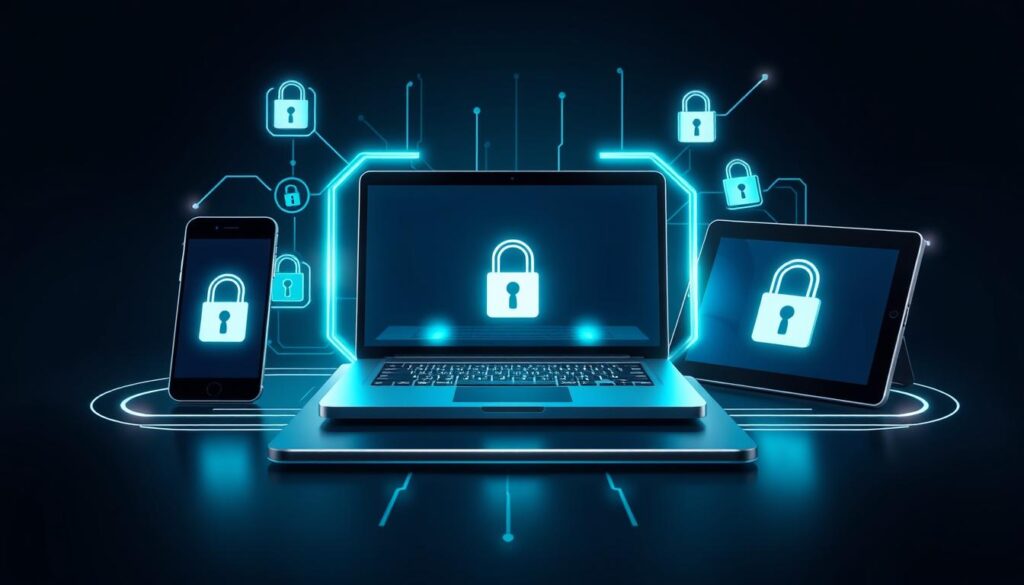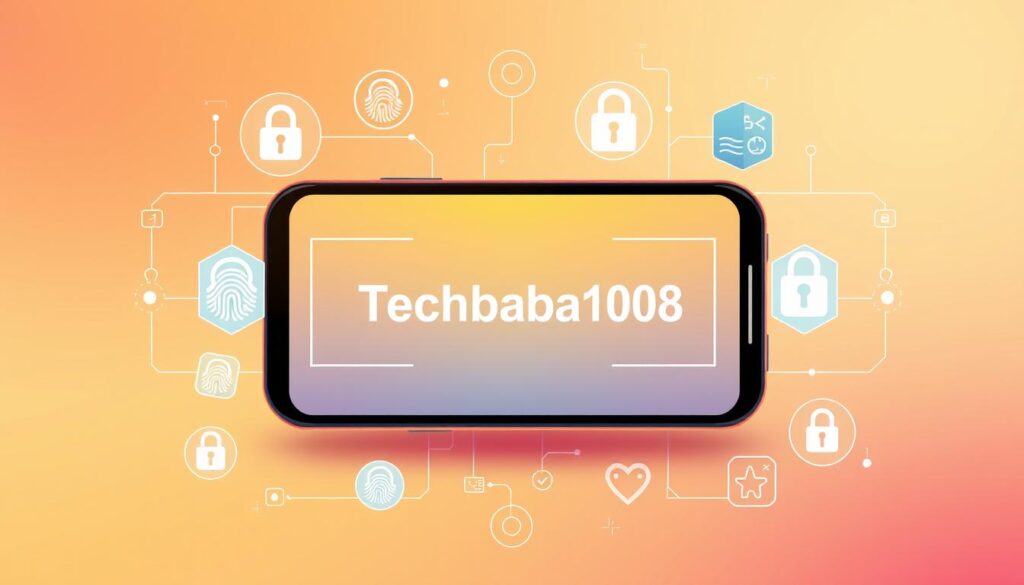“Essential Guide to Securing Your Personal Devices: Protect Your Smartphone, Laptop, and Tablet from
In today’s world, our personal devices are key to our daily lives. They hold our sensitive info, money, and memories. But, with cyber threats on the rise, keeping these devices safe is more important than ever. A study showed over 75% of Americans have faced a data breach on their devices, showing the urgent need for strong security.

This guide offers vital tips on protecting your devices, like smartphones, laptops, and tablets. It covers understanding threats and using top-notch security methods. You’ll get the info and tools to keep your digital world safe from cybercrime.
Key Takeaways
- Understand the common types of cyber attacks and why your personal devices are vulnerable
- Learn about the financial and personal consequences of security breaches
- Discover basic security measures to secure your personal devices
- Explore password management tools, biometric security options, and two-factor authentication
- Implement essential security software and update strategies
- Utilize data encryption and backup strategies for added protection
- Adopt safe browsing and network security practices to minimize risks
Understanding the Growing Threats to Personal Device Security
In today’s world, keeping our personal devices safe is crucial. This includes smartphones, laptops, and tablets. As technology gets better, so do the tricks used by hackers, threatening our data and privacy more than ever.
Common Types of Cyber Attacks
Our devices face many cyber threats. These include malware, phishing scams, and ransomware. Malware can steal your data or lock it up for money. Phishing scams trick you into giving away your login info. Ransomware encrypts your files, asking for money to unlock them.
Why Your Devices Are Vulnerable
Our devices are easy targets because we use them everywhere. Public Wi-Fi, old software, and weak passwords make them vulnerable. Identity theft prevention and data encryption methods are key to keeping them safe.
The Cost of Security Breaches
When a security breach happens, the damage can be huge. You might lose money or have your personal info stolen. This can hurt your credit and cause a lot of stress.
It’s essential to protect your devices in today’s digital world. Knowing the threats and taking steps to secure your devices can keep your data safe. This way, you can avoid falling victim to cybercrime.
How to Secure Personal Devices: Basic Security Measures
Protecting your personal devices like smartphones, laptops, and tablets is key today. A few simple steps can greatly improve your device’s security. Let’s look at some basic ways to keep your devices safe.
Set Up Strong Screen Locks
One basic step is to use a strong screen lock on your devices. Choose a complex passcode or use biometric features like fingerprint or facial recognition. These methods help block unauthorized access to your device.
Enable Automatic Updates
It’s important to keep your device’s software and apps updated. Enable automatic updates to get the latest security patches and bug fixes. This helps protect your device from vulnerabilities.
Utilize Built-in Security Features
- Activate device encryption to protect your data in case of loss or theft.
- Use the “Find My Device” feature to locate, lock, or remotely wipe your device if it goes missing.
- Enable the “Remote Wipe” option to erase sensitive data in the event of a security breach.
| Security Feature | Description |
|---|---|
| Screen Lock | Secure access to your device with a complex passcode, fingerprint, or facial recognition. |
| Automatic Updates | Keep your device’s software up-to-date to receive the latest security patches. |
| Device Encryption | Protect your data by enabling encryption on your device. |
| Find My Device | Locate, lock, or remotely wipe your device if it’s lost or stolen. |
| Remote Wipe | Erase sensitive data from your device in the event of a security breach. |
By following these basic steps, you can greatly improve your device’s security. This helps protect your sensitive information from cyber threats.

Creating Strong Passwords and Authentication Systems
In today’s digital world, cybersecurity threats keep changing. It’s key to focus on strong passwords and secure login systems. Making unique, strong passwords is the main way to guard your devices and private info.
Password Management Tools and Best Practices
Use tools like LastPass or 1Password to manage your passwords. They create and keep complex passwords for you. Here are some tips for keeping your passwords safe:
- Make long, unique passwords with letters, numbers, and symbols.
- Don’t use personal info, common words, or patterns in your passwords.
- Change your passwords often, especially for important accounts.
- Never share your passwords, not even with people you trust.
Biometric Security Options
Many devices now have biometric security like fingerprint or facial scans. These features add an extra layer of protection. They use your unique physical traits to confirm who you are. Using biometrics can greatly improve your secure password practices and cybersecurity tips.
Two-Factor Authentication Setup
Two-factor authentication (2FA) is a must for online account security. It asks for a second verification, like a code on your phone or a security key, along with your password. Turning on 2FA for key accounts like email, banking, and social media can greatly lower the chance of unauthorized access.
“The best defense against cyber threats is a proactive approach to personal device security, which starts with creating strong passwords and enabling robust authentication systems.”
Essential Security Software and Updates
In today’s digital world, keeping your devices safe is key. From smartphones to laptops, you need top-notch antivirus software recommendations and strong device privacy protection. The right security tools are crucial to protect your data and personal info from cyber threats.
Having the right security software is a must. Programs like Norton, McAfee, or Bitdefender offer strong protection against malware and viruses. They also include features like real-time scanning and VPN services to boost your device privacy protection.
It’s also vital to keep your software up-to-date. Developers are always fixing new bugs and improving their products. By updating your antivirus, operating system, and apps, you keep your devices safe from new threats.
| Antivirus Software | Key Features | Price Range |
|---|---|---|
| Norton | Real-time scanning, firewall, VPN, identity theft protection | $39.99 – $99.99 per year |
| McAfee | Comprehensive malware protection, web and email security, parental controls | $34.99 – $89.99 per year |
| Bitdefender | Advanced AI-powered threat detection, online privacy tools, cloud storage backup | $29.99 – $89.99 per year |
Investing in good antivirus software recommendations and device privacy protection is essential. Stay alert, update your software regularly, and take steps to keep your digital life safe.

Data Encryption and Backup Strategies
In today’s digital world, keeping your personal data safe is crucial. Using strong data encryption and backup plans can greatly improve your online safety. It helps protect your important information from unauthorized access or loss.
Cloud Storage Security
Secure cloud storage like Google Drive or Dropbox adds extra protection for your files. These services use encryption to keep your data safe, even when accessed from different devices. Always check the security and privacy policies of cloud storage providers to match your safety needs.
Local Backup Protection
Having local backups is key to keeping your data safe. Use external hard drives or USB flash drives for this. Make sure to encrypt these backups with tools like VeraCrypt or BitLocker to keep your data secure.
Encryption Tools and Methods
To boost your data protection, try different encryption tools and methods. Tools like VeraCrypt or BitLocker can lock down your files, folders, and even whole disks. This ensures your personal data stays safe, even if there’s a security breach.
| Encryption Tool | Key Features | Compatibility |
|---|---|---|
| VeraCrypt | Open-source, cross-platform encryption software with advanced security features | Windows, macOS, Linux |
| BitLocker | Built-in encryption solution in Windows 10, offering seamless integration and easy setup | Windows 10 and later |
With a solid data encryption and backup plan, you can protect your devices and sensitive info. This ensures your data and online safety are well-guarded against threats.
Safe Browsing and Network Security Practices
In today’s world, the internet is a big part of our lives. It’s important to keep internet safety for children and follow online safety guidelines. Safe browsing and network security help protect your devices and personal info from threats.
Using a secure Wi-Fi connection is key to safe browsing. Don’t use public or unsecured networks, as they can be risky. Instead, use a VPN or your home’s encrypted network for safe browsing.
Also, watch out for phishing scams. These scams look like real websites or messages but aim to steal your info. Always check the source and authenticity of emails, messages, or websites before sharing personal details.
- Implement robust parental controls on your children’s devices to limit their access to inappropriate or potentially harmful content online.
- Keep your web browsers and operating systems up-to-date with the latest security patches to address known vulnerabilities.
- Consider using a reliable antivirus or internet security software to detect and prevent malware infections.
By following these online safety guidelines and safe browsing practices, you can greatly improve internet safety for children. You’ll also protect your devices from cyber threats.
| Secure Browsing Tips | Network Security Practices |
|---|---|
| Use a VPN or encrypted home network | Implement parental controls |
| Beware of phishing scams | Keep software and browsers updated |
| Enable web browser security features | Use reliable antivirus/security software |
By following these online safety guidelines and staying alert with internet safety for children, you can greatly improve your device’s security. This will also protect your digital well-being.
Conclusion
In this guide, we’ve covered how to keep your devices safe from cyber threats. We talked about the different types of attacks and how to spot vulnerabilities. By taking these steps, you can lower the risk of data breaches and identity theft.
Keeping your phone, laptop, and tablet safe requires a multi-layered approach. This includes strong passwords, two-factor authentication, and keeping your software up to date. It’s also important to encrypt your data. Staying updated with the latest cybersecurity tips is key, as hackers’ methods change often.
By focusing on device security, you protect your own data and help make the internet safer for everyone. Use the strategies from this guide to stay safe online. Let’s work together to keep our devices secure and our digital lives safe from harm.
FAQ
What are the most common types of cyber attacks targeting personal devices?
Common cyber attacks include malware, phishing, ransomware, and data breaches. These threats can harm your device’s security. They can steal your sensitive information or destroy important data.
Why are personal devices vulnerable to security threats?
Personal devices like smartphones and laptops are at risk. They are always connected and hold sensitive info. Using public Wi-Fi without security can make them easy targets for hackers.
What are the potential consequences of a security breach on my personal devices?
A security breach can cause big problems. You might lose money, have your identity stolen, or have personal info exposed. It can also upset you and disrupt your life.
How can I set up basic security measures to protect my personal devices?
Start by setting up screen locks and automatic software updates. Use your device’s built-in security features. These steps can greatly improve your device’s protection.
What are the best practices for creating strong passwords and authentication systems?
Make strong passwords and use password managers. Enable two-factor authentication for extra security. Avoid simple passwords and consider biometric options like fingerprint or facial recognition.
What types of security software should I have installed on my personal devices?
You need antivirus software, firewalls, and VPNs. These tools can detect and block cyber threats. They also protect your online activities and data.
How can I ensure the security of my data through encryption and backup strategies?
Use encryption tools like VeraCrypt or BitLocker to protect your data. Back up your info regularly to secure cloud storage or local drives. This helps in case of data loss or theft.
What are some best practices for safe browsing and network security?
Always use secure Wi-Fi and be careful with public networks. Watch out for phishing attempts. Also, use parental controls and other safety measures if you have kids using your devices.
